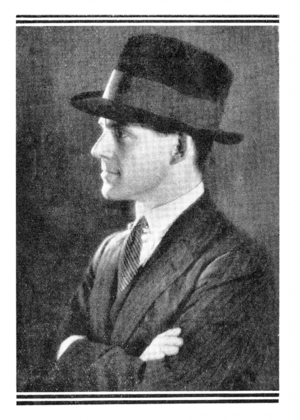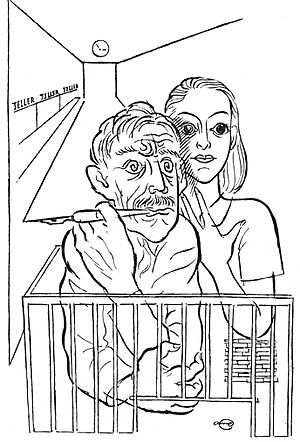Alan McLeod McCulloch facts for kids
Quick facts for kids
Alan McLeod McCulloch
AO
|
|
|---|---|

Alan McCulloch c.1934
|
|
| Born | August 5, 1907 St Kilda, Victoria |
| Died | December 21, 1992 (aged 85) Kew, Victoria |
| Education | Scotch College; Working Men's College, Melbourne; National Gallery of Victoria Art School |
| Genre | encyclopaedist, journalist, cartoonist, visual artist |
| Subject | art criticism, Australian art history, humour |
| Years active | 1935–1991 |
| Notable works | The Encyclopedia of Australian Art |
| Notable awards | Officer of the Order of Australia, Emeritus Medal, Australia Council |
| Spouse | Ellen Bromley Moscovitz (1908–1991) |
| Children | Susan |
| Relatives | Wilfred (brother) |
Alan McLeod McCulloch was a very important person in Australian art for over 60 years. He was an art critic, meaning he wrote about art. He was also an art historian, a gallery director, a cartoonist, and a painter. He was born on August 5, 1907, and passed away on December 21, 1992.
Contents
Early Life and Art Beginnings
Alan McLeod McCulloch was born in St Kilda, Melbourne, in 1907. His family later moved to Mosman, Sydney. His father really encouraged him to love the arts, so Alan became interested in art from a young age.
When Alan was ten, his father passed away, and his family moved back to Melbourne. He went to Scotch College for a few years. After that, he started working to help support his family. He worked at BHP and then as a teller at the Commonwealth Bank for 18 years.
In 1925, he was inspired by a famous cartoonist named Will Dyson. Alan decided to study art at night. He took classes at the Working Men's College and then at the National Gallery School until 1935.
A Career in Art and Writing
After writing about a painting in 1943, Alan McCulloch was hired as an art critic for a newspaper called Argus. This was from 1944 to 1947. After World War II, he became the art editor for a new magazine called Picture Post. He also drew cartoons for it.
The magazine aimed to be very high quality. They published works by famous Australian writers and artists. However, after three years, Alan and others were let go. This happened because they were fair in their reporting and did not show bias against certain artists, which the newspaper wanted.
Alan later recalled this time, saying he felt "on top of the world" and published many works by artists he believed would become great. But the newspaper thought his views were too "left-wing" and saw him as "dangerous."
In 1947, Alan traveled to the United States with his mother and a friend. In 1948, he married Ellen Bromley Moscovitz in Los Angeles. She was an Australian-born actress and businesswoman. They stayed together until her death in 1991.
Alan and Ellen toured America and Europe. They met famous artists like Marcel Duchamp and visited Georges Braque in Paris. They even cycled through Europe on a tandem bike! Alan wrote about these adventures in books like Highway Forty and Trial By Tandem.
Back in Australia in 1951, he became an editor for the magazine Meanjin. He also became the art critic for the Melbourne Herald newspaper from 1952 to 1982. In the 1960s, he was a correspondent for an international art magazine.
Alan was also an artist himself. He had several exhibitions of his paintings and drawings in London and Melbourne.
In 1965, he organized an exhibition of Aboriginal Bark Paintings. These paintings traveled to the USA.
From 1970 to 1992, Alan was the first director of the Mornington Peninsula Regional Gallery. Under his leadership, the gallery started collecting Australian prints and drawings. He also helped raise money for a new art center building in Mornington, which opened in 1991.
The Encyclopedia of Australian Art
In 1968, Alan McCulloch created his most important work: The Encyclopedia of Australian Art. This huge book became the main reference for anyone interested in Australian art. It started from a scrapbook of notes he had kept since the 1940s.
Alan was the only author for several updates and new editions of the encyclopedia. In 1990, his daughter Susan McCulloch joined him. She helped edit the third edition in 1994. Alan wrote a personal note for this edition, which was the last thing he wrote before he passed away.
In his note, he talked about how hard it is to define "art." He mentioned that even the creator of the Oxford English Dictionary found the word "art" to be one of the most difficult to define.
His daughter Susan and his granddaughter Emily McCulloch Childs, who are experts in Australian Indigenous art, have continued working on the Encyclopedia. They follow the rules Alan set in 1968. Artists are included if their work is in major galleries or if they have won important awards. The Encyclopedia is now in its 4th edition (2006).
Lasting Impact on Art
After his wife Ellen passed away in 1991, Alan moved to a retirement home in Kew. Even though he was recovering from an operation and had Parkinson's disease, he continued to make art. He also worked with his daughter Susan on the 3rd edition of their Encyclopedia.
To help with the costs of moving, Alan had to sell his collection of 450 artworks and other items. This auction happened in August 1991. Many collectors and friends bought his items. Even in a tough art market, many found good deals.
Alan McCulloch passed away on December 21, 1992. He is remembered as a strong supporter of modern Australian art. His Encyclopedia and his newspaper reviews helped promote many important artists. He supported artists like Charles Blackman, John Brack, Clifton Pugh, and Fred Williams.
Art critic Christopher Heathcote said that Alan McCulloch was "one of the great supporters of Modern Australian art." He believed that the art scene we know today would not have developed without Alan's dedication. He was considered one of the most influential art critics in Australia.
Alan also encouraged young artists. He became good friends with Arthur Boyd, who was only 15 when Alan encouraged him to become an artist. They even built a studio together where they both painted. Alan also helped start an Australian branch of the International Association of Art Critics.
Awards
- Officer of the Order of Australia (1976)
- Honorary doctorate from Melbourne University
- Emeritus Medal, Australia Council
Exhibitions
- 1991: Laughter on the Line, Mornington Peninsula Arts Centre
- 1953: Melbourne Painters Exhibition, Macquarie Galleries, Sydney, NSW (with other artists)
Collections Holding Works by Alan McCulloch
- National Gallery of Australia, Canberra, ACT
- National Gallery of Victoria, Melbourne, Victoria
- Mornington Peninsula Regional Gallery, Victoria
- Art Gallery of Western Australia, Perth, WA
Illustrated and Written by McCulloch
- McCulloch, Alan. So This Was The Spot (Melbourne, 1934)


